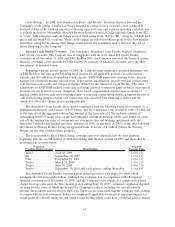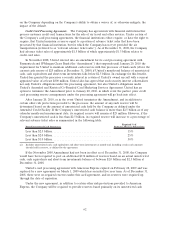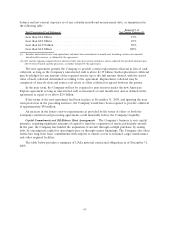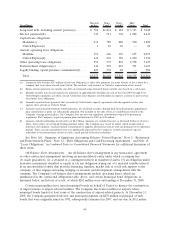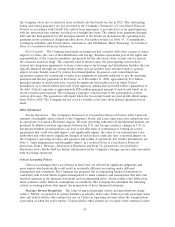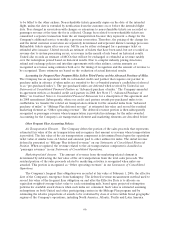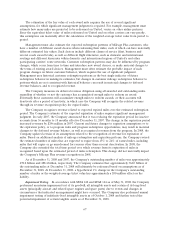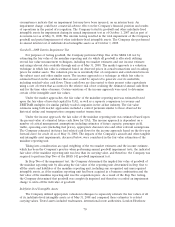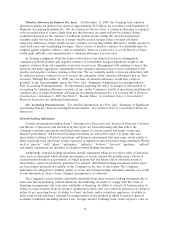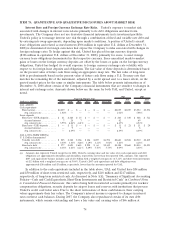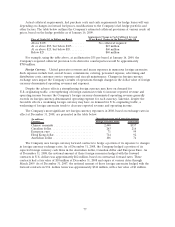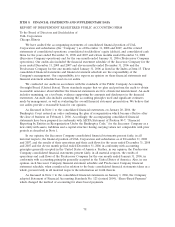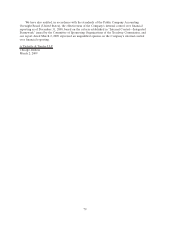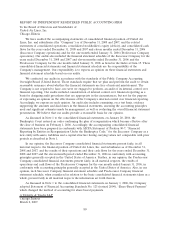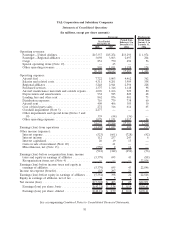United Airlines 2008 Annual Report Download - page 71
Download and view the complete annual report
Please find page 71 of the 2008 United Airlines annual report below. You can navigate through the pages in the report by either clicking on the pages listed below, or by using the keyword search tool below to find specific information within the annual report.slots and codesharing agreements. The Company used a market or income valuation approach, as
described above, to estimate fair values. Based on the preliminary results of this testing, the Company
recorded $80 million of impairment charges during the second quarter of 2008 and in the third quarter
of 2008 reduced the impairment charge by $16 million as a result of the finalization of the impairment
testing. No impairments of indefinite-lived intangible assets resulted from the Company’s annual
impairment test performed as of October 1, 2008.
Other Postretirement Benefit Accounting. The Company accounts for other postretirement benefits
using Statement of Financial Accounting Standards No. 106, Employers’ Accounting for Postretirement
Benefits Other than Pensions (“SFAS 106”) and Statement of Financial Accounting Standards No. 158,
Employers’ Accounting for Defined Benefit Pension and Other Postretirement Plans—an amendment of
FASB Statements No. 87, 88, 106 and 132(R) (“SFAS 158”). For the year ended December 31, 2006, the
Company adopted SFAS 158, which requires the Company to recognize the difference between plan
assets and obligations, or the plan’s funded status, in its Statements of Consolidated Financial Position.
Under these accounting standards, other postretirement benefit expense is recognized on an accrual
basis over employees’ approximate service periods and is generally calculated independently of funding
decisions or requirements. The Company has not been required to pre-fund its current and future plan
obligations, which has resulted in a significant net obligation, as discussed below.
The fair value of plan assets at December 31, 2008 and 2007 was $57 million and $56 million,
respectively, for the other postretirement benefit plans. The benefit obligation was $2.0 billion for the
other postretirement benefit plans at both December 31, 2008 and 2007. The difference between the
plan assets and obligations has been recorded in the Statements of Consolidated Financial Position.
Detailed information regarding the Company’s other postretirement plans, including key assumptions, is
included in Note 9, “Retirement and Postretirement Plans,” in Combined Notes to Consolidated Financial
Statements.
The following provides a summary of the methodology used to determine the assumptions disclosed
in Note 9, “Retirement and Postretirement Plans,” in Combined Notes to Consolidated Financial
Statements. The calculation of other postretirement benefit expense and obligations requires the use of a
number of assumptions, including the assumed discount rate for measuring future payment obligations
and the expected return on plan assets. The discount rates were based on the construction of theoretical
corporate bond portfolios, adjusted according to the timing of expected cash flows for the payment of
the Company’s future postretirement obligations. A yield curve was developed based on a subset of these
bonds (those with yields between the 10th and 90th percentiles). The projected cash flows were matched
to this yield curve and a present value developed, which was then calibrated to develop a single
equivalent risk-adjusted discount rate.
Actuarial gains or losses are triggered by changes in assumptions or experience that differ from the
original assumptions. Under the applicable accounting standards, those gains and losses are not required
to be recognized currently as other postretirement expense, but instead may be deferred as part of
accumulated other comprehensive income and amortized into expense over the average remaining
service life of the covered active employees. The Company’s accounting policy is to not apply the
corridor approach available under SFAS 106 with respect to amortization of amounts included in
accumulated other comprehensive income. Under the corridor approach, amortization of any gain or
loss in accumulated other comprehensive income is only required if, at the beginning of the year, the
accumulated gain or loss exceeds 10% of the greater of the benefit obligation or the fair value of assets.
If amortization is required, the minimum amount outside the corridor divided by the average remaining
service period of active employees is recognized as expense. The corridor approach is intended to reduce
volatility of amounts recorded in pension expense each year. Since the Company has elected not to apply
the corridor approach, all gains and losses in accumulated other comprehensive income are amortized
and included in pension expense each year. At December 31, 2008 and 2007, the Company had
unrecognized actuarial gains of $286 million and $254 million, respectively, recorded in accumulated
other comprehensive income for its other postretirement benefit plans.
71


